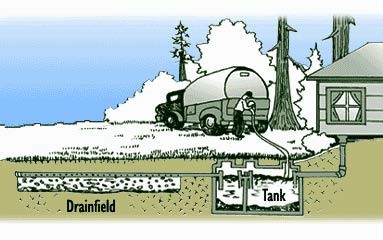Septic System Basics
A septic system has two main components: a septic tank which traps and biologically degrades solid waste and a drainfield which provides additional biological treatment and infiltration of the water into the ground. Septic systems require regular maintenance to prevent costly damage and repairs. Septic systems are designed to safely use natural processes such as "helpful bacteria" to treat and dispose of the wastewater generated in your home.
If a septic system is not maintained, untreated human waste may contaminate drinking water supplies and negatively impact the environment. Keeping your septic system working properly is a wise investment for economic, human health, and environmental reasons.
Pumping the septic system regularly will prevent the system from overflowing. If a septic tank overflows, the wastewater mixes with solid waste in the tank possibly clogging the associated drainfield causing sinks and toilets to "back up". The raw waste may flow into drinking water wells or runoff into streams that lead to the ocean and estuaries, contaminating shellfish and ultimately resulting in waters that are not fit to swim in.
High water tables found along Coastal Georgia can also have a tremendous impact on septic systems. During times of heavy rainfall and coastal flooding, water leaks into the systems through cracks.
Heavy rain storms that seasonally occur along the coast can quickly and easily waterlog your system, making it drain very slowly. Signs of this include toilets not flushing properly and sinks draining very slowly. If you see any of these signs, you can ease the impacts on your septic system by fixing household leaks, reducing the number of toilet flushes and washing clothes at a laundromat.
